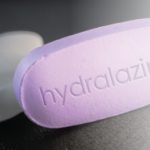Correct!
C) Tumor necrosis factor (TNF)–α-induced palmoplantar pustular psoriasis
Though anti–TNF-α treatments are very effective in treating psoriasis, they may paradoxically induce psoriasis, including a variant of pustular psoriasis. Most frequently, anti–TNF-α-induced psoriasis occurs in the setting of rheumatologic disease, but cases associated with inflammatory bowel disease and with native psoriasis are well documented. Women aged 40 to 50 years are most commonly affected, though cases in men are not uncommon, and cases in children have been described.1-3 The duration of treatment with anti–TNF-α prior to the development of psoriatic lesions is variable, but the lesions tend to occur beyond the first two weeks of treatment. This delay helps distinguish this condition from a hypersensitivity drug reaction.1,2
The clinical presentation of anti–TNF-α–induced psoriasis can vary. In some cases, patients present with widespread, well-demarcated erythematous plaques with silvery adherent scale, typical of plaque-type psoriasis. In other patients, the clinical picture is dominated by pustular patches and plaques confined to the palms and soles, resembling palmoplantar pustular psoriasis. The latter form best describes this patient’s case. A recent review confirmed the frequent observation that, while palmoplantar psoriasis accounts for only 1.7% of patients with native psoriasis, it is the most common manifestation of TNF-α–induced psoriasis, with 42.9% of TNF-α–induced cases in the literature reported to be of this subtype.1 Scalp psoriasis is also common.4
Infliximab has been implicated as the most common anti–TNF-α drug to induce psoriasis.1,5,6 Cases associated with etanercept, adalimumab, and certolizumab pegol have also been described, and most authors believe that anti–TNF-α therapy–induced psoriasis is a class effect.
In patients who are being treated for native psoriasis, anti–TNF-α therapy–induced psoriasis can present with lesions that are distinct and show a different distribution pattern from the original psoriasis.1,6 This distinction holds true if the patient develops psoriasis when rechallenged with a second anti–TNF-α therapy. Thus, it appears anti–TNF-α medications can cause de novo psoriasis in psoriatic patients, rather than simply exacerbating a preexisting condition.
The management of patients with anti–TNF-α therapy–induced psoriasis is not well established. Many authors recommend initiating or increasing topical therapy (corticosteroids, calcipotriene, or retinoids) for psoriasis as initial therapy. If this is not successful, the anti–TNF-α therapy may need to be discontinued, and/or additional systemic therapy initiated. Discontinuation of the anti–TNF-α agent results in complete or partial resolution in the majority of cases, and switching to a different anti–TNF-α may occasionally be helpful despite the apparent class effect.2,6,7 In cases with refractory and severe skin disease, the addition of methotrexate, ultraviolet therapy, phototherapy, cyclosporine, or oral retinoinds may be helpful.8 Recently, the use of cyclosporine with transition to ustekinumab has been advocated.9
Dr. Femia is a fellow in the dermatology–rheumatology fellowship at Brigham and Women’s Hospital in Boston. She is a diplomat of the American Board of Dermatology.
Dr. Merola is an instructor in the department of dermatology at Harvard Medical School and a fellow in the rheumatology division at Brigham and Women’s Hospital, both in Boston. He is the assistant program director for the combined medicine–dermatology training program and a diplomat of the American Board of Dermatology and the American Board of Internal Medicine.
References
- Joyau C, Veyrac G, Dixneuf V, Jolliet P. Anti-tumor necrosis factor alpha therapy and increased risk of de novo psoriasis: Is it really a paradoxical side effect? Clin Exp Rheumatol. 2012 Aug. [Epub ahead of print]
- Wollina U, Hansel G, Koch A, Schoonlebe J, Kosteler E, Haroske G. Tumor necrosis factor-alpha inhibitor-induced psoriasis or psoriasiform exanthemata: First 120 cases from the literature including a series of six new patients. Am J Clin Dermatol. 2008;9:1-14.
- Perman MJ, Lovell DJ, Denson LA, Farrell MK, Lucky AW. Five cases of anti-tumor necrosis factor alpha-induced psoriasis presenting with severe scalp involvement in children. Pediatr Dermatol. 2012;29:454-459.
- Cullen G, Kroshinsky D, Cheifetz AS, Korzenik JR. Psoriasis associated with anti-tumour necrosis factor therapy in inflammatory bowel disease: A new series and a review of 120 cases from the literature. Aliment Pharmacol Ther. 2011;34:1318-1327.
- Denadai R, Teixeira FV, Steinwurz F, Romitis R, Saad-Hossne R. Induction or exacerbation of psoriatic lesions during anti-TNF-alpha therapy for inflammatory bowel disease: A systematic literature review based on 222 cases. J Crohns Colitis. 2012 Sep 6. [Epub ahead of print]
- Collamer AN, Battafarano DF. Psoriatic skin lesions induced by tumor necrosis factor antagonist therapy: Clinical features and possible immunopathogenesis. Semin Arthritis Rheum. 2010;40:233-240.
- Cohen JD, Bournerias I, Buffard V, et al. Psoriasis induced by tumor necrosis factor-alpha antagonist therapy: A case series. J Rheumatol. 2007;34:380-385.
- Gerdes S, Franke J, Domm S, Mrowietz U. Ustekinumab in the treatment of palmoplantar pustulosis. Br J Dermatol. 2010;163:1116-1118.
- Chu D, Van Voorhees A, Rosenbach M. Treatment of refractory tumor necrosis factor inhibitor-induced palmoplantar pustulosis: A report of two cases. Arch Dermatol. 2011;147:1228-1229.


